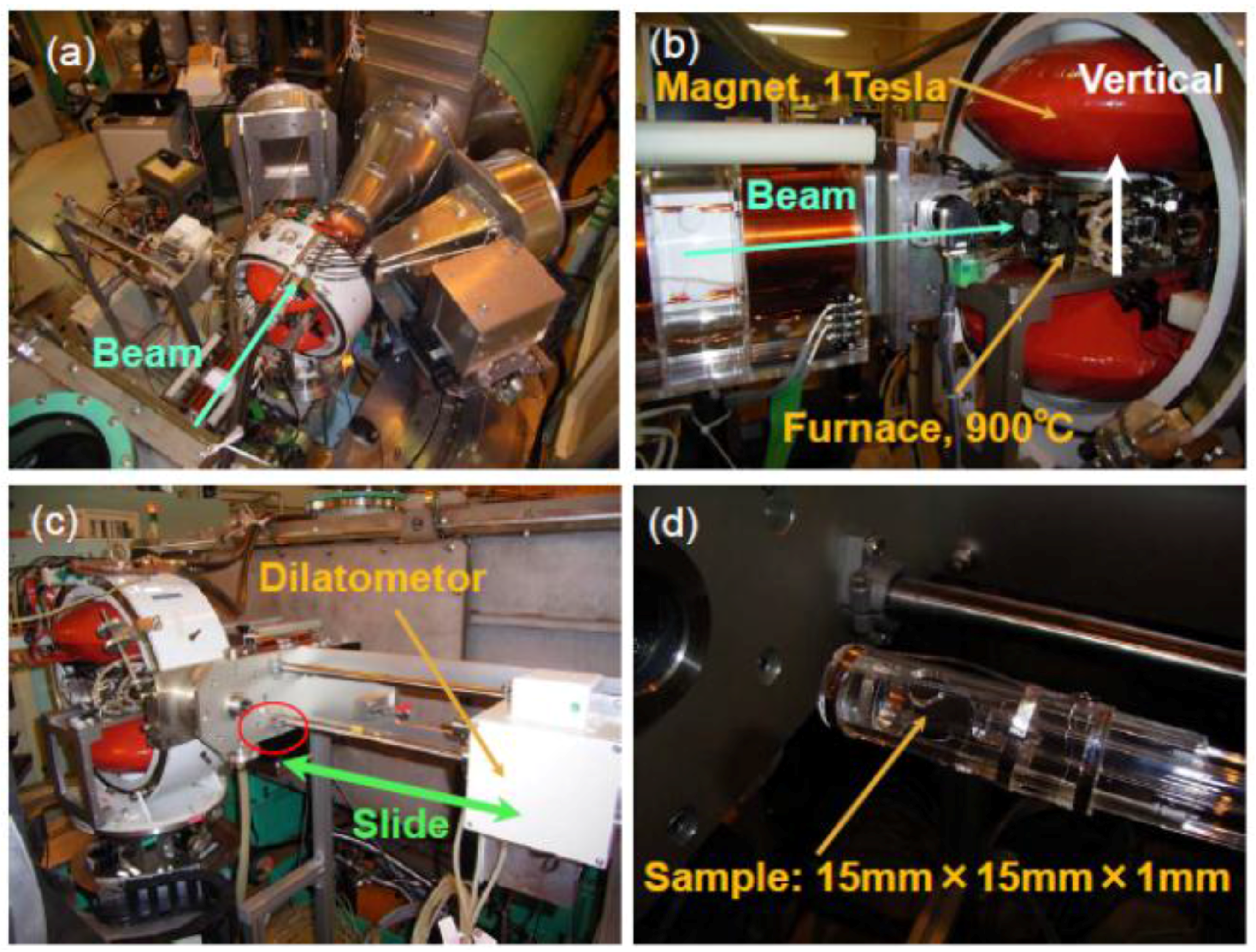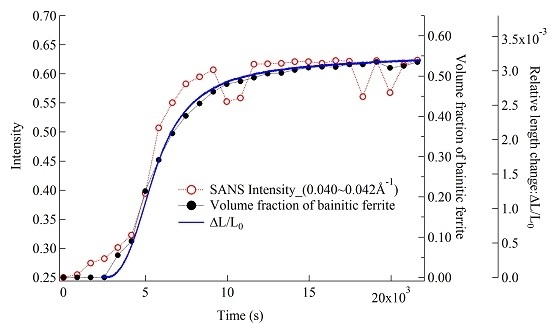Monitoring of Bainite Transformation Using in Situ Neutron Scattering
Abstract
:1. Introduction
2. Experimental Procedures
2.1. Specimen Preparation
2.2. Small Angle Neutron Scattering Methods

2.3. Data Analysis on Small Angle Neutron Scattering
3. Results and Discussion
3.1. Monitoring of Bainite Transformation by Dilatometry

3.2. Monitoring of Bainite Transformation with in Situ SANS




3.3. In Situ Measurements of Dilatometry, Small Angle Scattering and Diffraction at iMATERIA

- (1)
- ND: crystal structure and volume fraction of constituents, texture, carbon concentration, elastic strain, and dislocation density: bulk average or three-dimensional (3D) distribution by scanning technique, although it requires scan time.
- (2)
- SANS: volume fraction, shape and size of the second phase: bulk average.
- (3)
- BE: phase volume fraction and carbon concentration of austenite, hopefully simultaneous 2D mapping of volume fraction, grain size, elastic strain and texture.

4. Conclusions
Acknowledgments
Author Contributions
Conflicts of Interest
References
- Furukawa, T. Structure-property relationships of dual phase steels. J. Jpn. Inst. Met. 1980, 19, 439–446. [Google Scholar] [CrossRef]
- Tomota, Y.; Tamura, I. Strength and deformation behavior of two-ductile- phase alloys. J. Jpn. Inst. Met. 1985, 14, 657–664. [Google Scholar] [CrossRef]
- Tomota, Y.; Tamura, I. Mechanical Behavior of Steels Consisting of Two Ductile Phases. Trans. ISIJ 1982, 22, 665–677. [Google Scholar] [CrossRef]
- Matsumura, O.; Sakuma, Y.; Takechi, H. Enhancement of elongation by retained austenite in intercritical annealed 0.4C–1.5Si–0.8Mn steel. Trans. ISIJ 1987, 27, 570–579. [Google Scholar] [CrossRef]
- Tomota, Y.; Tokuda, H.; Adachi, Y.; Wakita, M.; Minakawa, N.; Moriai, A.; Morii, Y. Tensile Behavior of TRIP-Aided Multi-Phase Steels Studied by in situ Neutron Diffraction. Acta Mater. 2004, 52, 5737–5745. [Google Scholar] [CrossRef]
- Caballero, F.G.; Bhadeshia, H.K.D.H.; Mawella, J.A.; Jones, D.G.; Brown, P. Very strong low temperature bainite. Mater. Sci. Technol. 2002, 18, 279–284. [Google Scholar] [CrossRef] [Green Version]
- Garcia-Mateo, C.; Caballero, F.G.; Bhadeshia, H.K.D.H. Development of Hard Bainite. ISIJ Int. 2003, 43, 1238–1243. [Google Scholar] [CrossRef]
- Beladi, H.; Adachi, Y.; Timokhina, I.; Hodgson, P.D. Crystallographic analysis of nanobainitic steels. Scr. Mater. 2009, 60, 455–458. [Google Scholar] [CrossRef]
- Timokhina, I.; Beladi, H.; Xiong, X.Y.; Adachi, Y.; Hodgson, P.D. Nanoscale microstructural characterization of a nanobainitic steel. Acta Mater. 2011, 59, 5511–5522. [Google Scholar] [CrossRef]
- Carcia-Mateo, C.; Jimenz, J.A.; Yen, H.-W.; Miller, M.K.; Morales-Rivas, L.; Kuntz, M.; Ringer, S.P.; Yang, J.-R.; Caballero, F.G. Low temperature bainitic ferrite: Evidence of carbon super-saturation and tetragonality. Acta Mater. 2015, 91, 162–173. [Google Scholar] [CrossRef]
- Speer, J.G.; Streicher, A.M.; Matlock, D.K.; Rizzo, F.C.; Krauss, G. Austenite Formation and Decomposition; Damm, E.B., Merwinm, M., Eds.; TMS/ISS: Warrendale, PA, USA, 2003; pp. 502–522. [Google Scholar]
- Speer, J.; Matlock, D.; de Cooman, B.; Schroth, J. Carbon partitioning into austenite after martensite transformation. Acta Mater. 2003, 51, 2611–2622. [Google Scholar] [CrossRef]
- Edmonds, D.; He, K.; Rizzo, F.; de Cooman, B.; Matlock, D.; Speer, J. Quenching and partitioning martensite—A novel steel heat treatment. Mater. Sci. Eng. A 2006, 438, 25–34. [Google Scholar] [CrossRef]
- Santofimia, M.J.; Zhao, L.; Sietsma, J. Overview of mechanism involved during the quenching and partitioning process in steels. Metall. Mater. Trans. A 2011, 42A, 3620–3626. [Google Scholar] [CrossRef]
- Yuan, L.; Ponge, D.; Wittig, J.; Choi, P.; Jimenez, J.A.; Raabe, D. Nanoscale austenite reversion through partitioning, segregation and kinetic freezing: Example of a ductile 2 GPa Fe–Cr–C steel. Acta Mater. 2012, 60, 2790–2804. [Google Scholar] [CrossRef]
- Caballero, F.G.; Bhadeshia, H.K.D.H. Very Strong Bainite. Curr. Opin. Solid State Mater. Sci. 2004, 8, 251–257. [Google Scholar] [CrossRef]
- Koo, M.S.; Xu, P.; Suzuki, H.; Tomota, Y. Bainitic transformation behavior studied by simultaneous neutron diffraction and dilatometric measurement. Scr. Mater. 2009, 61, 797–800. [Google Scholar] [CrossRef]
- Gong, W.; Tomota, Y.; Koo, M.S.; Adachi, Y. Effect of ausforming on nanobainite steel. Scri. Mater. 2010, 63, 819–822. [Google Scholar] [CrossRef]
- Gong, W.; Tomota, Y.; Adachi, Y.; Paradowska, A.M.; Kelleher, J.F.; Zhang, S.Y. Effects of ausforming temperature on bainite transformation, microstructure and variant selection in nanobainite steel. Acta Mater. 2013, 61, 4142–4154. [Google Scholar] [CrossRef]
- Gong, W.; Tomota, Y.; Harjo, S.; Su, Y.H.; Aizawa, K. Effect of prior martensite on bainite transformation in nanobainite steel. Acta Mater. 2015, 85, 243–249. [Google Scholar] [CrossRef]
- Babu, S.S.; Specht, E.D.; David, S.A.; Karapetrova, E.; Zachack, P.; Peer, M.; Bhadeshia, H.K.D.H. In situ Observations of Lattice Parameter Fluctuations in Austenite and Transformation to Bainite. Metall. Mater. Trans. A 2005, 36A, 3281–3289. [Google Scholar] [CrossRef]
- Stone, H.J.; Peet, M.J.; Bhadeshia, H.K.D.H.; Withers, P.J.; Babu, S.S.; Specht, E.D. Synchrotron X-ray studies of austenite and bainitic ferrite. Proc. Roy. Soc. A 2008, 464, 1009–1027. [Google Scholar] [CrossRef]
- Gong, W. Transformation Kinetics and Crystallography of Nano-bainite Steel. Ph.D. Thesis, Ibaraki University, Hitachi, Japan, March 2012. [Google Scholar]
- Huang, J.; Vogel, S.C.; Poole, W.J.; Militzer, M.; Jacques, P. The study of low-temperature austenite decomposition in a Fe–C–Mn–Si steel using the neutron Bragg edge transmission technique. Acta Mater. 2007, 55, 2683–2691. [Google Scholar] [CrossRef]
- Muller, G.; Uhlemann, M.; Ulbricht, A.; Bohmert, J. Influence of hydrogen on the toughness of irradiated reactor pressure vessel steels. J. Nucl. Mater. 2006, 359, 114–121. [Google Scholar] [CrossRef]
- Ohnuma, M.; Suzuki, J.; Wei, F.G.; Tsuzaki, K. Direct observation of hydrogen trapped by NbC in steel using small-angle neutron scattering. Scr. Mater. 2008, 58, 142–145. [Google Scholar] [CrossRef]
- Buckley, C.E.; Birnbaum, H.K.; Bellmann, D.; Staron, P. Calculation of the radial distribution function of bubbles in the aluminum hydrogen system. J. Alloy. Compd. 1999, 293–295, 231–236. [Google Scholar] [CrossRef]
- Yasuhara, H.; Sato, K.; Toji, Y.; Ohnuma, M.; Suzuki, J.; Tomota, Y. Size Analysis of Nanometer Titanium Carbide in Steel by Using Small-Angle Neutron Scattering. Tetsu-to-Hagane 2010, 96, 545–549. [Google Scholar] [CrossRef]
- Su, Y.H.; Morooka, S.; Ohnuma, M.; Suzuki, J.; Tomota, Y. Quantitative Analyses on Cementite Spheroidization in Pearlite Structure by Small-Angle Neutron Scattering. Metall. Mater. Trans. A 2015, 46A, 1731–1740. [Google Scholar] [CrossRef]
- Oba, Y.; Koppoju, S.; Ohnuma, M.; Kinjo, Y.; Morooka, S.; Tomota, Y.; Suzuki, J.; Yamaguchi, D.; Koizumi, S.; Sato, M.; et al. Quantitative Analysis of Inclusions in Low Carbon Free Cutting Steel Using Small-Angle X-ray and Neutron Scattering. ISIJ Int. 2012, 52, 458–464. [Google Scholar] [CrossRef]
- Schelten, J.; Schmatz, W. Multipe-Scattering Treatment for Small Angle Scattering Problem. J. Appl. Cryst. 1980, 13, 385–390. [Google Scholar] [CrossRef]
- Järvinen, M. Texture Effect in X-ray Analysis of Retained Austenite in Steels. Textures Microstruct. 1996, 26–27, 93–101. [Google Scholar] [CrossRef]
- Gnäuperl-Herold, T.; Creuziger, A. Diffraction study of the retained austenite content in TRIP steels. Mater. Sc. Eng. A 2011, 528, 3594–3600. [Google Scholar] [CrossRef]
- Oishi, T.; Yonemura, M.; Morishima, T.; Oshikawa, A.; Torii, S.; Ishigaki, T.; Kamiyama, T. Application of matrix decomposition algorithms for singular matrices to Pawley method in Z-Rietveld. J. Appl. Cryst. 2012, 45, 299–308. [Google Scholar] [CrossRef]
© 2016 by the authors; licensee MDPI, Basel, Switzerland. This article is an open access article distributed under the terms and conditions of the Creative Commons by Attribution (CC-BY) license (http://creativecommons.org/licenses/by/4.0/).
Share and Cite
Nishijima, H.; Tomota, Y.; Su, Y.; Gong, W.; Suzuki, J.-i. Monitoring of Bainite Transformation Using in Situ Neutron Scattering. Metals 2016, 6, 16. https://doi.org/10.3390/met6010016
Nishijima H, Tomota Y, Su Y, Gong W, Suzuki J-i. Monitoring of Bainite Transformation Using in Situ Neutron Scattering. Metals. 2016; 6(1):16. https://doi.org/10.3390/met6010016
Chicago/Turabian StyleNishijima, Hikari, Yo Tomota, Yuhua Su, Wu Gong, and Jun-ichi Suzuki. 2016. "Monitoring of Bainite Transformation Using in Situ Neutron Scattering" Metals 6, no. 1: 16. https://doi.org/10.3390/met6010016





